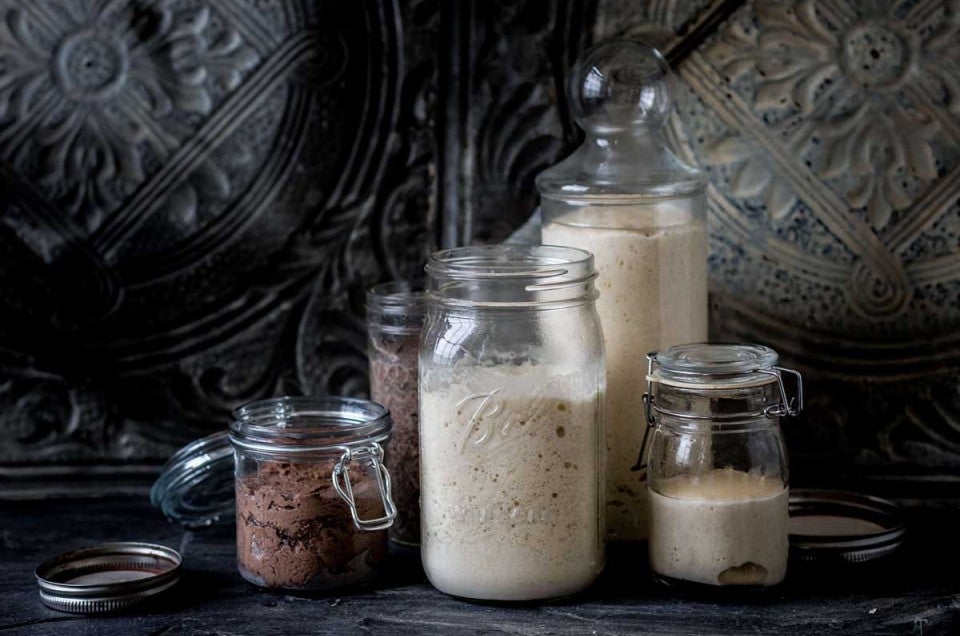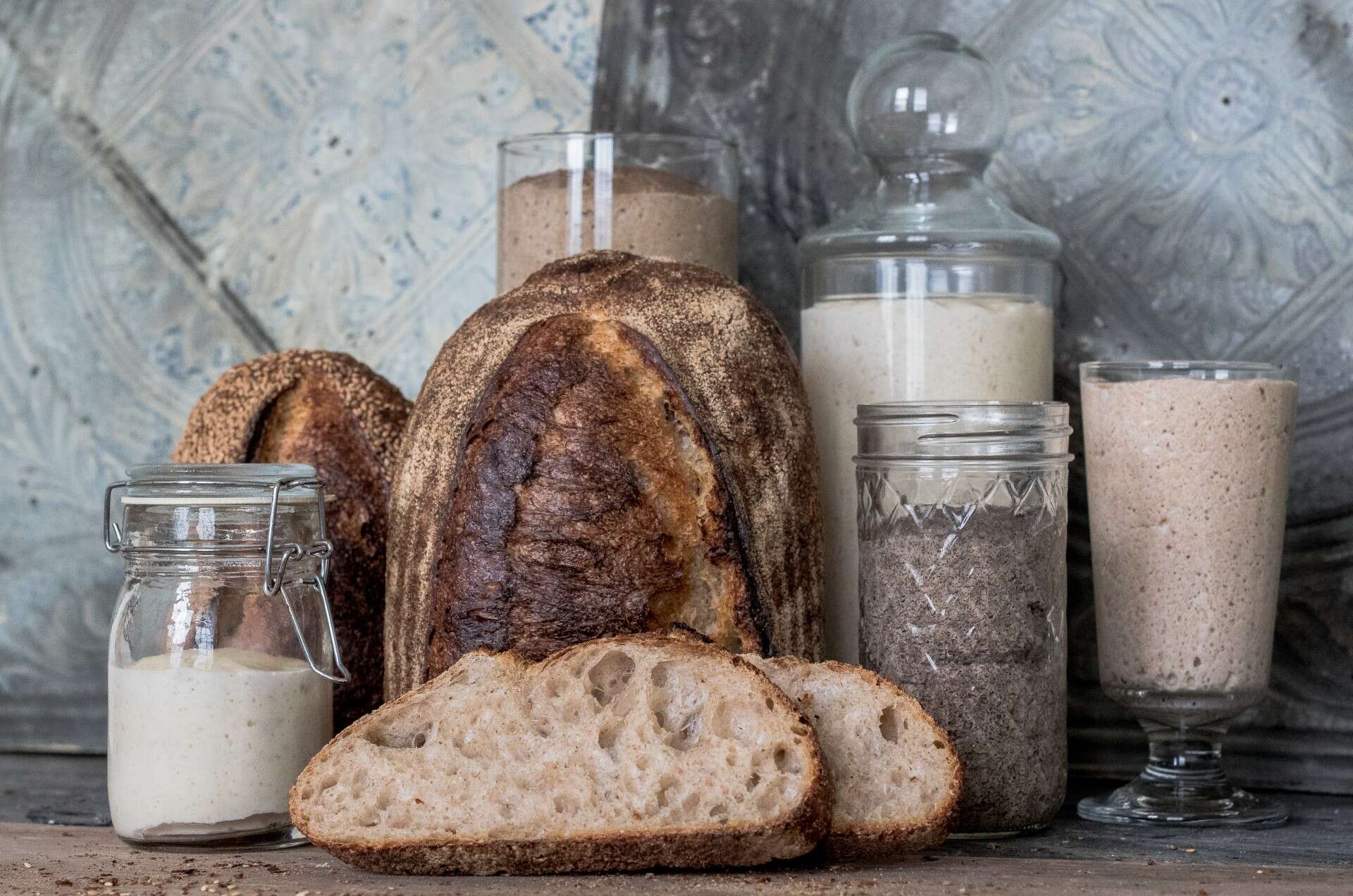Baking with preferments
Poolish? Biga? Levain? Unlock great flavor by understanding the four key varieties


When I began baking bread, I made many loaves in pursuit of “the one.” Like looking for a lost pet, my car keys, or a favorite pair of jeans, I searched day and night, baking until I found some special ingredient or technique that would elevate my bread to the level of loaves from my favorite bakeries.
You may recognize this chase. Maybe your bread obsession is in full swing, yet while your shaping is improving and your confidence is on the rise, does full flavor still elude you?
In my case, one small change revealed the missing piece. As the first loaf cooled and its aroma filled the kitchen (my whole apartment!), I knew I had turned a corner.
The key to my newfound success? Preferments.

A preferment is a mixture of flour, water, leavening (commercial yeast or sourdough starter), and time — a key ingredient! As the mixture ferments over the course of 12 to 16 hours, the delicious by-products of that fermentation build up and infuse the starter, the dough, and the finished loaf. You may have heard names like sourdough starter, biga, poolish, levain, pâte fermentée, or even desem. All of these are preferments.
Flour + Yeast (or Starter) + Water + Time = FLAVOR
The preferment family is a group of oddballs. Some are active and will blow the lid off a container, while others prefer to take it easy. Whole grain flour is all the rage in some cases, but cross an international border and bakers might swear by all-purpose flour instead. Regardless of which flours you use or what name you give it, preferments generally fit into one of four categories. Understanding these four groups helped me make sense of everything else.
In order to streamline things, I group common preferments into categories based on hydration and leavening.
Hydration, in baker’s parlance, refers to the ratio of flour to liquid. A "stiff" preferment has low moisture and the consistency of bread dough. On the other end of the hydration spectrum, a "liquid" preferment has the consistency of pancake batter.
For leavening, I divide preferments into two categories as well. “Starter” means that the flour and water mixture is leavened with a sourdough culture, which contains wild yeast. Alternatively, “commercial yeast” refers to anything from instant to fresh compressed commercial yeast.
We’ll get to examples of each type in just a moment. For now, focus on the idea that most preferments fall into one of the four categories below.
| Starter | Commercial Yeast | |
|---|---|---|
| Liquid | Liquid Starter | Liquid Yeasted |
| Stiff | Stiff Starter | Stiff Yeasted |
OK. Simple enough. Four styles, four ways to inject flavor (like a bouillon cube of fermentation) into your bread.
But what about all those international names and baker’s jargon? In my early days of trying to understand preferments, the nomenclature tripped me up. I have a clear memory of my confusion as I tried to sort the difference between “poolish” and “levain.” Both are preferments. Both are liquid. So what's the difference? It wasn’t until I began to think in these boxes that I gained some clarity.
Here’s the table from above, again. I’ve kept the headings and the more common terms that bakers use to describe preferments. I haven’t listed everything under the sun — please chime in in the comment section with any common names you think I’ve missed!
| Starter | Commercial Yeast | |
|---|---|---|
| Liquid | Liquid Starter - Liquid Levain - Levain Liquide - Lievito Liquido |
Liquid Yeasted - Poolish - Sponge |
| Stiff | Stiff Starter - Stiff Levain - Masa Madre - Lievito Madre - Mother - Rye Starter |
Stiff Yeasted - Biga - Pâte Fermentée |
It's easy to imagine the difference between a stiff and a liquid preferment, but is there really a difference between when you use a starter versus commercial yeast?
Yes! Starter is a symbiotic colony of bacteria and yeast (SCOBY). In broad terms, a SCOBY is comprised of bacterial and fungal populations living in symbiosis. The by-products of their activities bring complex flavors and aromas to the starter, dough, and resultant loaves.
Commercial yeast, in contrast, has yeast but no bacterial populations. The flavors associated with a “yeasted” preferment are delicious but also gentler and, to my palate and nose, less complex. It’s not that one is better or worse than the other — they are different, each bringing their own nuance to the bread party.

Over many years, bakers and eaters have identified reliable and favorable matches that pair specific preferments with specific breads. These are not rules but rather starting points for getting your feet (hands!) wet. Try the standards and then see what happens when you switch things up.
My early loaves were made with a liquid starter (top left in the table). The complexity of the starter, the slight acidity, the almost “cheesy” notes combined with a long fermentation lit a fire in me that continues to this day. A classic example of bread that calls for a liquid starter is Naturally Leavened Sourdough Bread.
The most famous example of liquid yeasted (top right in the table) is probably poolish, the preferment of choice for Classic Baguettes. In addition to its "nutty" flavor, poolish can make baguette doughs easier to handle – the preferment boosts extensibility (the ability for dough to stretch).
Traditional dark rye breads often call for a stiff starter (bottom left of the table). Rye starter is crucial because the acidity from fermentation aids in strengthening the dough. You can make decent rye bread without a stiff starter – much in the same way that you can make a baguette without a poolish – but now you know why this style of perferment lives in so many traditional rye recipes, such as Jeffrey's Sourdough Rye Bread.
Italian breads are often made with a biga. The stiff yeasted preferment (bottom right of the table) perfumes the finished loaf with floral, aromatic qualities that are unrivaled. If Ciabatta is made with anything other than a biga, I can always smell the change.

When I mix a preferment, knowing that I get to make bread the next day, something changes. It’s a shift inside my head — somewhere, a light turns on. It feels like excitement, hope, and a hunger for the loaf, but also for the process. I encourage you to give preferments a shot.
For more information on starters, check out our Sourdough Baking Guide, which walks you through how to create — or buy — a healthy starter that can fuel a lifetime of delicious loaves.


April 26, 2021 at 4:04pm
In reply to Thank you for systematizing… by Chava Weissler (not verified)
You sure can, Chava! Using a whole grain in your poolish or biga will also impart more flavor. Happy baking!
April 6, 2021 at 2:16pm
You have some great video's and posts Mr. Philip. You are obviously quite skilled. I watched your video about making Pain Au Levain and then tried the recipe. Your preferement in the video was "wet dough like," but the recipe's preferment was very dry and in fact failed to rise. Due to my lack of skill and experience I didn't realize I had a problem. What ratio of ingredients did you use in your preferment?
Thanks,
April 6, 2021 at 2:57pm
In reply to You have some great video's… by Gary (not verified)
We're sorry to hear that you had some trouble with that recipe, Gary! It sounds like a bit too much flour snuck its way into the mixing bowl which can make for a poor rise. To ensure you have the proper amount of flour we recommend either using a kitchen scale to weigh your ingredients or using the fluff and sprinkle technique for measuring flour in volume. We hope this helps for future baking adventures!
March 13, 2021 at 4:47pm
After leaving my biga rise overnight I decided the next day to postpone baking bread for a week. My question: How long can I keep the biga in the fridge until ready to use?
March 15, 2021 at 11:31am
In reply to After leaving my biga rise… by Walter (not verified)
Hi Walter! Unfortunately, that poor biga has reached the end of its life. For a biga, we tend to make sure to bake it within an 18-hour window. You want to bake with it right at the peak of ripeness, and we've found anytime after 18 hours is past its ripe stage. Sorry about that. But thanks so much for reaching out, and we hope you give it ago again. Happy baking!
March 6, 2021 at 3:08pm
This article would be more useful if it included hydration ratios for the different types of preferments.
March 11, 2021 at 3:42pm
In reply to This article would be more… by Leo (not verified)
Thanks for this feedback, Leo! We'll share it forward to our blog team. Be well and happy baking!
April 12, 2021 at 8:52pm
In reply to Thanks for this feedback,… by mmoss
That would be highly appreciated.
August 8, 2020 at 1:46pm
Thank you for this article and the wonderful comments. I've been using preferments for a few years, but never had a clear description of the different types. (I had naively assumed they were the same, but with names coming from different languages.) I particularly liked the comment on converting a recipe to use preferment, which I have tried a couple of times with the pretzel bites recipe.
Are there any types of breads where you would recommend against using a preferment? So far, I've only used them in relatively plain breads - sandwich, baguettes, dinner rolls, etc.
July 19, 2020 at 2:53am
Thanks for all your generous sharing of knowledge. I love the journey I have now started with bread baking. I have been using poolish for a few weeks now, mainly in Jeffrey's focaccia recipe, but today I am using a biga in your ciabatta recipe (inspired by your YouTube tutorial). And I agree with your sentiments around the excitement just mixing up the pre-ferment brings. I'm also excited the next day when I look in the pre-ferment bowl and it's all bubbly and happy and smelling delicious. Just wonderful.
Pagination